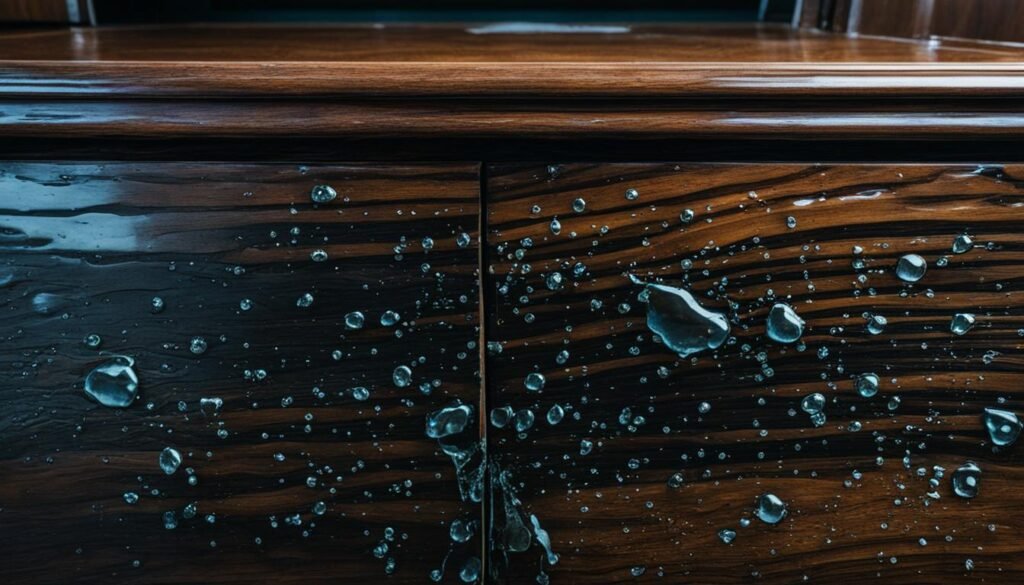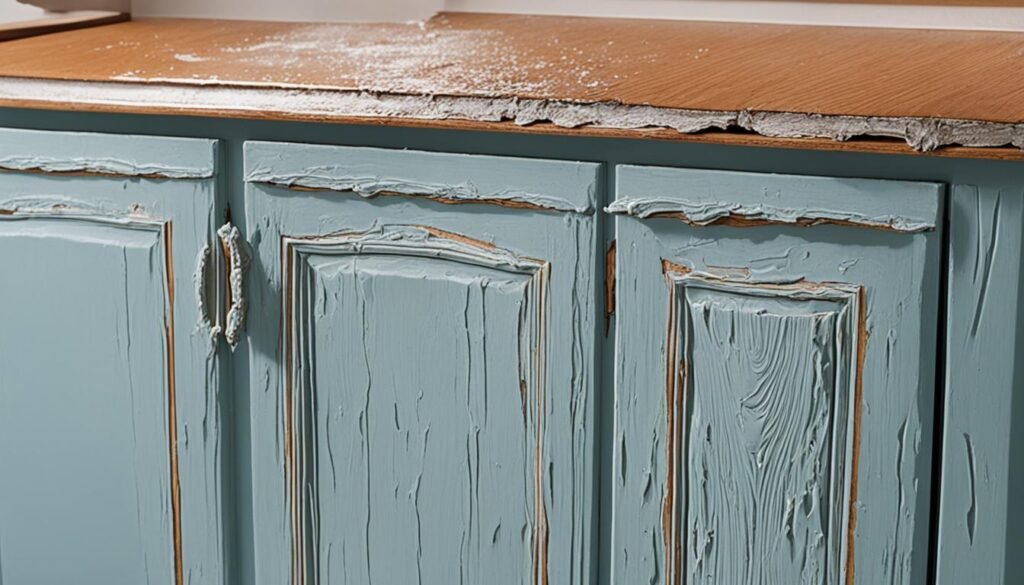Did you know water damage is a top reason for kitchen cabinet failure? In fact, over 40% of kitchen cabinet replacements are because of water issues. If your cabinets have gotten wet, don’t worry – you can fix them.
This guide will show you how to spot, check, and fix water-damaged cabinets. You’ll learn how to handle discoloration, warping, swelling, or mold. Experts use specific steps to make your cabinets look new again. Say goodbye to water stains and welcome a fresh kitchen look.
Key Takeaways
- Water damage can show in many ways, like discoloration, warping, swelling, or mold.
- Not all water-damaged cabinets are beyond repair – with the right methods, they can look new again.
- Learn how to spot and check the water damage on your kitchen cabinets.
- Discover the best materials and ways to repair and refinish water-damaged cabinets.
- Follow expert steps to fix your water-damaged cabinets and refresh your kitchen.
Identifying and Assessing Water Damage on Cabinets
Before fixing water-damaged cabinets, it’s key to spot and assess the damage. Water damage shows up in many ways, each needing a specific fix. Knowing the signs of moisture damage helps you tackle the root cause and stop further damage.
Signs of Moisture Damage to Cabinets
Look for discoloration, stains, and wood or veneer bubbling or peeling. Warped surfaces and mold also signal moisture issues. The damage’s severity depends on the cabinet’s materials. Engineered woods like MDF are more prone to water damage.
Materials and Their Water Resistance
The type of wood used in cabinets affects their water resistance. MDF, an engineered wood, quickly breaks down in moisture. Plywood is stronger, with layers of wood veneers that resist water better. Solid wood cabinets are best in damp places, as they don’t warp or get permanent damage from water.
| Cabinet Material | Water Resistance |
|---|---|
| MDF (Medium-Density Fiberboard) | Low |
| Plywood | Moderate |
| Solid Wood | High |
Fixing water damage on cabinets quickly is vital to prevent more issues. Spotting moisture damage and knowing how different materials handle water helps you fix the problem. This way, you can bring your kitchen cabinets back to their best state.
How to Fix Water Damaged Cabinets
Fixing water-damaged cabinets might seem hard, but it can be done right. First, find and fix the moisture source. Use fans and dehumidifiers to dry out the area well. Sometimes, you’ll need to take the cabinet down to get all moisture out.
After drying, clean the cabinets. A mix of vinegar can get rid of mold or mildew. Sanding gets the surface ready for refinishing. Small repairs can be done with wood glue. But, big damage might mean you need to replace parts.
Finally, put on a waterproof sealant to protect against water later. This step is key to stop water damage from happening again. It helps your cabinets last longer.
Step-by-Step Guide to Fixing Water Damaged Cabinets
- Find and fix the moisture source to stop more damage.
- Use fans and dehumidifiers to dry out the area well.
- Clean the cabinets with a vinegar-based solution to remove mold and mildew.
- Sand the damaged surfaces to prepare them for refinishing.
- Repair minor warping or separation using wood glue.
- Replace severely damaged sections if necessary.
- Apply a waterproof sealant to protect against future water damage.
By following these steps, you can fix water damaged cabinets and make your kitchen look great again. Quick action and the right methods are key for a lasting fix.

“The key to successfully repairing water-damaged cabinets is to address the root cause of the moisture issue. With the right approach, you can breathe new life into your kitchen and prevent future damage.”
Conclusion
Fixing water-damaged cabinets takes time and care, but it’s worth it to keep your kitchen looking good. This guide shows you how to fix your cabinets without needing to replace them. If the damage is too much or you’re not sure what to do, think about getting help from a pro like FloodFixers for advice on fixing your cabinets and kitchen.
Dealing with water damage can be tough, but you can fix it with the right steps. Catching water damage early can stop it from getting worse and save you money on repairs later. By being careful and using the tips in this guide, you can make your water-damaged cabinets look new again.
Whether you like to do things yourself or need expert help, fixing cabinets means knowing about water damage, picking the right materials and methods, and working step by step. With the info and tools here, you can fix your water-damaged cabinets and keep your kitchen looking great for a long time.


